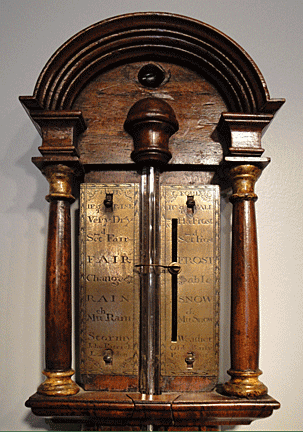 Many
inventions happen by accident. So it was with the mercury barometer
which Evangelista Torricelli, a physicist and mathematician from
Florence, Italy in 1641 originally intended to measure elevation
rather than predict the weather.
Many
inventions happen by accident. So it was with the mercury barometer
which Evangelista Torricelli, a physicist and mathematician from
Florence, Italy in 1641 originally intended to measure elevation
rather than predict the weather.
Torricelli’s colleague, Vincenzo Viviani, actually performed the
experiment which demonstrated the existence of atmospheric pressure
the following year. He took a glass tube, about two arms long,
sealed at one end and filled it with mercury. Then, with a finger
over the open end, he inverted the
 tube
and plunged it into a bowl of mercury. As soon as he removed his
finger, the level of the mercury in the tube dropped a little,
leaving a column of mercury that was about 70 cms high—as long as
the open end of the tube remained immersed in the bowl of mercury.
Torricelli drew the correct conclusion: atmospheric pressure on the
surface of the mercury prevented all the mercury from escaping. He
also concluded that the space at the top of the tube, caused by the
dropping of the mercury, had to be a vacuum. Torricelli concluded
that because the height of the mercury varied from day to day, the
fluctuations had to be the result of changes in the atmospheric
pressure.
tube
and plunged it into a bowl of mercury. As soon as he removed his
finger, the level of the mercury in the tube dropped a little,
leaving a column of mercury that was about 70 cms high—as long as
the open end of the tube remained immersed in the bowl of mercury.
Torricelli drew the correct conclusion: atmospheric pressure on the
surface of the mercury prevented all the mercury from escaping. He
also concluded that the space at the top of the tube, caused by the
dropping of the mercury, had to be a vacuum. Torricelli concluded
that because the height of the mercury varied from day to day, the
fluctuations had to be the result of changes in the atmospheric
pressure.
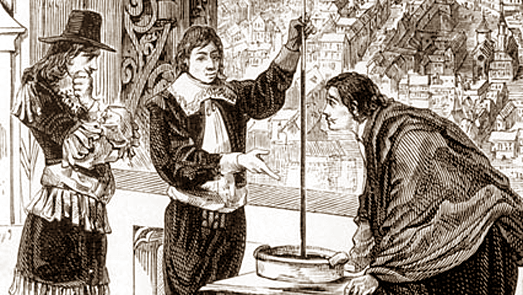
In 1648,
physicist Rend Descartes and mathematician Blaise Pascal of France
added a paper scale to “Torricelli's tube,” creating the first
working barometer. It was Pascal's theory that air pressure
decreased with altitude above sea level. He enlisted his
brother-in-law, Florin Perier, to carry the barometer up to the peak
of Mount Puy-de-Dome. Pascal's hypothesis proved correct since
Perier observed diminishing mercury column height as he climbed to
the mountain's summit.
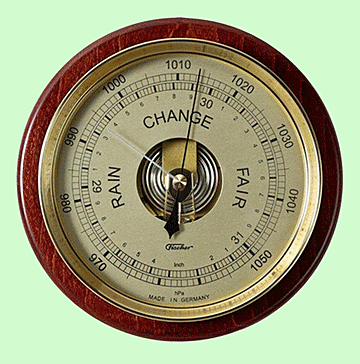 Then
not much happened with the development of the barometer until 1660,
when two English scientists, Robert Boyle and Robert Hooke, first
observed correlations between variations in atmospheric pressure and
changes in the weather. Their experiments led to the development of
a practical barometer, and by 1670, the leading clock and instrument
makers in England began to construct barometers for scientific and
domestic use.
Then
not much happened with the development of the barometer until 1660,
when two English scientists, Robert Boyle and Robert Hooke, first
observed correlations between variations in atmospheric pressure and
changes in the weather. Their experiments led to the development of
a practical barometer, and by 1670, the leading clock and instrument
makers in England began to construct barometers for scientific and
domestic use.
By the time Charles II left the throne of England in 1685, the
English dominated barometer production and continued to do so for
the next two centuries. Today, the largest quantity and widest range
in styles of mercury barometers available to collectors are of
English origin.
Early Barometer Makers
Members of the Clockmakers' Company, a guild founded in London under
Royal Charter of King Charles I, made most of the barometers during
the late 17th to early 18th centuries. Two of the primary makers
were Daniel Quare, watch and clockmaker to George I and inventor of
the repeating watch, and Thomas Tompion. From 1720 to 1800, London
instrument makers, including Jesse Ramsden, acknowledged as the most
skillful designer of mathematical, astronomical and navigational
instruments in the 18th century, and Peter Dollond, a respected
maker of optical and surveying instruments, also made barometers.
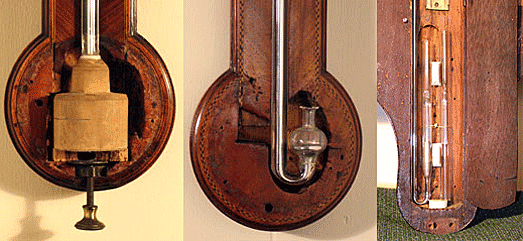
Until the last two of decades of the 18th century, the barometer
remained mainly a scientific instrument, available only to serious
scientists and the wealthy. Around this time, enterprising Italian
migrants began to arrive in England. They made domestic barometers
and sold them at affordable prices. From the end of the 18th
century, the domestic barometer became one of the “must-haves,” of
the upper classes—a thing of science, function and beauty to
complement their decor and furnishings and to impress their friends.
The Stick Barometer

The
earliest domestic barometer was made in the stick style. The case
consisted of a shaft of wood that protected the fine-bore mercury
tube. The top few inches, however, housed the scale—printed on paper
or engraved on a rectangular plate of silvered copper—that allowed
the owner to read the height of the mercury which fluctuated between
28 to 31inches according to the air pressure. Because the mercury
might only move by a small fraction of an inch, it was not easy to
take a really accurate reading, so barometer makers added a sliding
secondary scale, a vernier, to make it possible to observe
fluctuations of 1/100s of an inch.
The scale was often protected by a hinged and glazed door and topped
by a pediment. Almost the whole length of the tube might be visible,
or just those top few inches. The reservoir, or cistern, at the
bottom, however, would always be hidden and protected by a cistern
cover.
Outline stringing, the choice of quality mahogany veneers often laid
in a chevron pattern, and elegant engraving, could all be used to
make the barometer not only aesthetically pleasing but functional.
Instruments made for royalty and rich aristocrats, however, were
unique and of the highest quality imaginable. The makers were eager
to please their wealthy clientele with fine cabinetry and metalwork.
Unfortunately, many of the cases suffered when people brought them
to America. The atmosphere in England is notoriously wet, so
barometer cases fell apart or cracked when they were exposed to
America’s drier climate.
The Banjo or Wheel Barometer
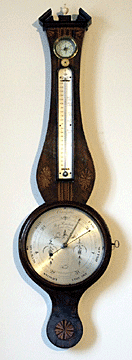
During
the last quarter of the 18th century, the shape of barometers
changed with the arrival of Italian instrument makers to England.
They produced a variety of styles in great quantity, marked with
their own names. One of the earliest and most prolific families was
the Somalvicos, who set up shop in London around 1780, and continued
to practice well into the 19th century.
The banjo barometer, also referred to as a wheel or dial barometer,
was first made in England around 1790 and soon became the style of
choice. As time evolved, additions to the case included a
hygrometer, an instrument that measures humidity, a thermometer, a
convex `butler's' mirror and a level.
A wheel barometer has a long siphon tube, which makes a U-turn at
the bottom, creating a short hook that acts as the “reservoir” for
the mercury in what’s commonly referred to as the “short limb.” Air
pressure on the surface of the mercury in the short limb is enough
to support the whole column. A glass weight rests on the surface of
the mercury in the short limb of this tube. Mercury is so dense that
the glass weight really does float on it. The maker then sealed the
top of the tube to create a vacuum.
Styles of Wheel Barometer
While the technical parts wheel barometers are the same, the cases
followed the furniture trends of the time, especially in the type of
wood used. Until 1720, walnut was the wood of choice. Later examples
included rosewood and mahogany, with ebony and satinwood trim, and
inlaid mother-of-pearl or shell also being used. Case styles
reflected those of the leading furniture designers of the
times—Chippendale, Hepplewhite, Sheraton, and later the revival
styles of the Victorian Era. Until 1840, makers usually used brass
for the register plates, but in Victorian times, ivory and bone were
popular.
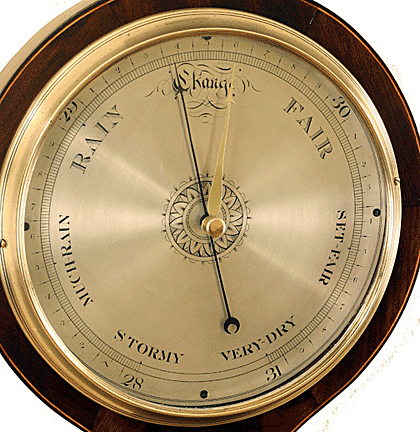
Wheel
barometers tend to be described by their pediments, diameter of
dial, and the number of components they contain. Generally, they had
two types of pediments. Round top pediments, popular during the late
18th and early 19th centuries, were just a smooth rounded end to the
case. Broken arch or triangular pediment consisted of a molded
isosceles triangle, with the apex section removed. The rectangular
gap was often ornamented by a brass finial. Though the most popular
pediment of the Regency period, by 1830 the scroll pediment had
replaced it.
Barometers made in America were scarce until 1840. The ones that did
exist were machine-made stick forms, similar to the mantel and shelf
clocks made in the same era. These were cheaply made, using grain
painting, thin veneers, machine-made moldings and crude assembly
methods. Thus, the cost of restoration of these barometers may far
exceed their value.
Since barometers are scientific instruments, the country of origin
must appear on them, and in many cases, the maker also includes his
name and address. Unless specifically made for export, the weather
indicators are also written in the language of the country for which
the barometer had been made.
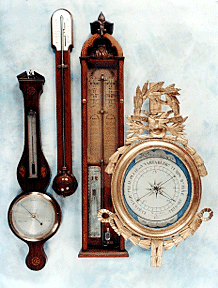
The
fragile nature of the barometer and their operating mechanisms means
that restoration is very common and one that can have a major effect
on the value if overdone, or improperly done.
The biggest problem with mercury barometers is that their owners
don’t know how to read them properly. Often a barometer will read
“Fair” when its raining outdoors. That's because a barometer is a
device for predicting weather changes. It was never meant to provide
an instant readout of current conditions. A change in the level of
the mercury indicates the passage of a high- or low-pressure front
over an area and a corresponding change in weather. Falling
atmospheric pressure precedes stormy or unsettled conditions while a
rise indicates the approach of fair weather.
Mercury barometers should never be moved suddenly because air
bubbles in the column upset the calibration of the instrument. Also,
because mercury is a hazardous material, mercury barometers cannot
be transported by airplane.
Moving Mercury Barometers
Mercury barometers should be moved with special care and kept
upright in transit. If the mercury moves suddenly its weight could
shatter the glass tube. Stick barometers have a little key square at
the base. Turn this until the column of mercury reaches the top of
the tube. Wheel barometers must be corked by a specialist before
being moved.
